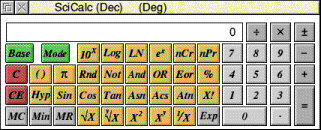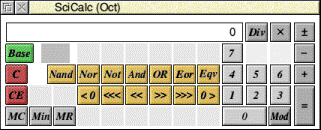
 |
www.riscos.com Technical Support: |
| SciCalc is in the Apps directory on your hard disc or network. To start the application double-click on the !SciCalc application icon. The icon will then appear on the icon bar. |
Click on the icon bar icon to display the calculator window.

There are two ways of entering numbers into the calculator. You can use the mouse to move the pointer over the required key and then click, or you can use the keyboard directly. Clicking in the numeric display turns the title bar a cream colour, indicating that numbers and selected operators may be entered from the keyboard. When the title bar is grey, the keyboard does not affect the state of SciCalc.
If you use the numeric keypad, make sure that the Num Lock key is on. The keys in the numeric keypad are also equivalent to those on the calculator keypad.
These operate exactly like an ordinary calculator, except that you can enter numbers and operators (+, -, etc) either by clicking on the SciCalc display or by using the numeric keypad on the keyboard. When you enter a number it appears in the calculator's display. When you first load SciCalc it is set for normal decimal arithmetic (to base 10). This is denoted by the word (Dec) in the title bar.
SciCalc treats the calculation you enter as a formula and does not perform the calculation until you click on the Equals button. SciCalc performs the calculation according to the precedence of operators. From highest to lowest; Multiply, Divide, Add and Subtract.
Multiplication takes place before addition so:
2 + 6 x 5 = 32 (not 40)
You can change the order of calculation by using brackets:
To multiply 2 by 5 and view the result, enter the following in this order:
2 x 5 =
The result will appear in the display.
The ± key switches the sign of x.
The percentage function operates as follows: to increase x by y percent, press:
x + y %
To decrease x by y percent, type - instead of +.
Press CE to clear the current display. For example, pressing the following:
2 + 6 x 3 CE 5 =
calculates
2 + 6 x 5 =
Press C to clear not only the display but also the whole input so far.
SciCalc has a single memory. To enter the displayed value into the memory, press Min. To display the contents of the memory, press MR. To clear the memory, press MC.
To callculate the square root of x, press the square root symbol, then x.
To obtain the yth root of x, press y, then the square root symbol, then x, followed by y. For example, to calculate the fourth root of 52, click on the following keys:
52 y which will display the result 2.685349614.
To calculate the square of x, click on x2.
To raise x to a power other than 2, click on xy followed by the power you want to take. For example, to raise 52 to the power 4, click on the following keys:
52 xy 4 =
which will display the result 7311616.
For example, to raise 10 to the nth power, press 10x. To raise e to the nth power, press ex. (e is defined as 2.7182818).
For the reciprocal of x, press 1/x.
To obtain the logarithm (base 10) of x, press LOG.
For the natural logarithm (base e), press LN.
To obtain a bracket, press (). The same key produces a left or right bracket, whichever is appropriate in the context. For example, to calculate (2 + 3) x 5, press
() 2 + 3 () x 5 =
(There is only one level of brackets available.)
To use pi in a calculation, press the pi symbol.
To express x in exponent form, press Exp followed by y, the exponent. For example,
50 Exp 4 =
Among the more advanced functions available in SciCalc are the standard trigonometric functions.
SIN sine To obtain hyperbolic trigonometric functions, press Hyp before pressing the function button.
As already mentioned, when first loaded SciCalc normally works with decimals. Successive clicks on Base switch it to binary (base 2), octal (base 8) and hexadecimal (base 16) bases. The current base is shown in the Title bar. The calculator layout is modified to provide the input requirements for each base: for bases using fewer than ten characters, some are greyed out, while for hex, some of the function keys are replaced with the necessary letters. In addition, when a function is not available in a base, it is greyed out. For example, in base 8 SciCalc looks like this;
Base provides a handy way of converting a number between bases. Once you have entered a number into the display, clicking on Base converts it successively to the other bases.
In the non-decimal bases - binary, octal and hexadecimal - the arithmetic functions are augmented by a MOD function. In addition, the scientific functions are replaced by logic functions: NAND, NOR, NOT, AND, OR, EOR, EQV, rotate, arithmetic shift and logic shift.
You can switch between degrees, radians and gradians by clicking on the Mode button; the current unit is shown in the Title bar.
Changing from decimal to a non-decimal base rounds the currently displayed value to the nearest integer, but has no effect on previous parts of the current calculation. Rounding also occurs on numbers being recalled from memory in non-decimal bases.
Operators are evaluated in the following order of precedence (highest shown first):
SciCalc's accuracy is limited to that of BASIC VI - 64-bit floating point.
Modes and their Numeric range
Note: Real number underflow is not trapped.
These features are stored by setting up SciCalc as you wish to use it, and then saving the features by creating a Desktop boot file.
Calculating squares and powers
Calculating reciprocals and factorials
Calculating logarithms
Using brackets
Using pi
Calculating exponents
Trigonometric functions
COS cosine
TAN tangent
ASN arcsine (sine-1)
ACS arccosine (cosine-1)
ATN arctangent (tangent-1)
Changing the number base

Logic functions in the non-decimal bases
Degrees, radians and gradians
Keyboard short-cuts
Calculator functions and their keyboard equivalents
Calculator Keyboard equivalent (if any) Function 0...9 0...9 numbers +, -, x, /,= +, -, *, /, = standard operators Return, Enter same as = ± # change sign on number or exponent Exp E allows entry of exponent . . decimal point 10x, LOG, LN, eX exponential and logarithmic functions xCy combination xPy permutation () (, ) brackets (one level only) Pi the number Pi RND random number between 0.0 and 1.0 NOT, AND, OR, EOR logical functions % % percentage HYP (followed by a trig function) hyperbolic functions SIN, COS, TAN trigonometric functions ASN, ACS, ATN inverse trigonometric functions x! ! factorial SQRTx square root ySQRTx Yth root of X x2 square xY ^ X raised to the power Y /x reciprocal C Delete clear calculation CE clear current number only MC clear memory Min memory in MR memory recall Mode select radians/degrees/gradians Base select decimal/binary/octal/hexadecimal base Keyboard equivalents in non-decimal bases
Calculator Keyboard equivalent (if any) Function NAND none NOT AND NOR none NOT OR EQV none NOT EOR (equivalence) <O , O> none rotate left or right <<< , >>> none logical shift left or right << , >> none arithmetic shift left or right DIV none integer division MOD none modulus (integer remainder) A - F A - F hexadecimal base digits Operator precedence
Technical notes
Numeric range
-9.9E307 to 9.9E307 displayable
Accuracy
Modes Their accuracy Number of digits displayed Binary Absolute 32 Octal Absolute 10 - 11 Hexadecimal Absolute 8 Decimal 64-bit FP 10 or 10 + 2 digit exponent Saving features in a Desktop boot file
You may wish to change some aspects of the way SciCalc operates. For example, the position of the SciCalc window when it is opened, the number base it uses and the angle mode.
RISC OS 3.7 User Guide - 22 JAN 1997
![]()
![]()
![]()
![]()
![]()
Last Edit: Tue,03 Nov 2015